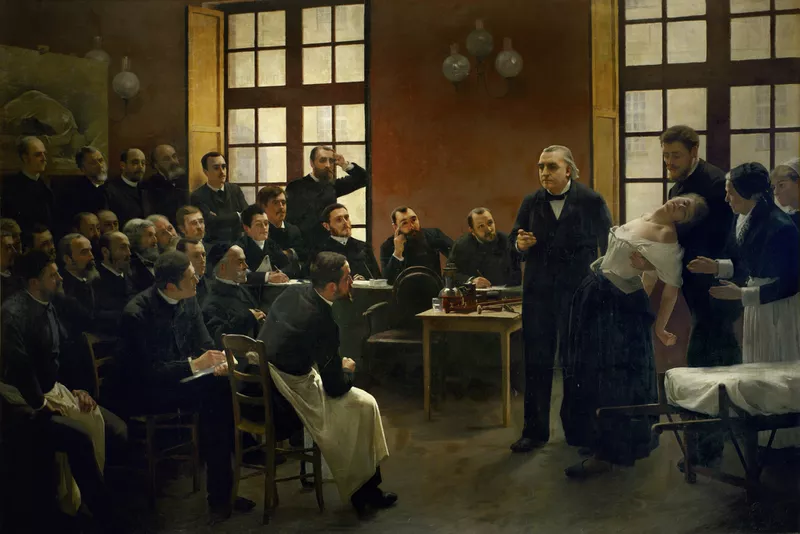Hysteria as a Misogynistic Construct
Have you ever been in the situation where you show emotion during a discussion and you are told "you are being hysterical, just calm down"? Apart from the fact that this "advice" has the opposite effect to the one intended - it is likely to make you even more agitated - it is also more commonly directed at women than men. Why is it that the concept of hysteria often bears connotations of a misogynistic slur? And, indeed, what does "hysteria" even mean? The answers to these questions span a wide historical plain and are illuminating with regard to male attitudes to women and emotions.

The word "hysteria" derives from the ancient Greek word hystera, meaning "uterus" (Cherry, 2022). It was commonly thought that a woman’s uterus could become displaced, which would cause a "wandering uterus" (McVean, 2017). This wandering uterus was identified as the main cause of the strong emotions associated with the proposed condition. However, when one thinks of the study of hysteria, one does not think about ancient Greece, one is more likely to conjure up images of dark-suited men somewhere between the late 1800s and early 1900s. Two such men were Jean-Martin Charcot, with his work at La Salpêtrière, and Sigmund Freud, with his work in Vienna (Bogousslavsky, Dieguez, 2014). These two men were actually connected: at the beginning of his career, Freud spent a few months working with Charcot at La Salpêtrière, and the work he did there would leave a big impression on him (Bogousslavsky, Dieguez, 2014). Their work with "hysterical" patients led them to observe that the sickness could affect men as well as women, although they noted that these cases were less in number. (Bogousslavsky, Dieguez, 2014). This marked an important turning point in the study of the disease, which heretofore had been associated with the uterus and therefore female-specific. (McVean, 2017)

Chalcot and Freud concluded that hysteria was a sickness, but they also observed that while it was associated with physical symptoms, it was not physical in essence. The telltale symptoms of hysteria that could result in admittance to La Salpêtrière were “blindness, emotional outbursts, hallucinations, histrionic behavior (being overly dramatic or excitable), increased suggestibility, loss of sensation” (Cherry, 2022). But, as observed by Bogousslavsky and Dieguez:
Hysteria was first explained by repressed shameful or harmful experiences, subsequently uncovered by a therapeutic cathartic process involving hypnosis, pressure on the forehead, or the free association of words; then by actual early experiences of sexual abuse, and then not, after all, by actual abuses, but by a process of fantasy involving the imagining of seduction scenes as an attempt to solve a universal conflicting experience through which all normal infants have to go. (2014, p. 110)
Freud reworked his understanding of hysteria a lot throughout the years (Bogousslavsky, Dieguez, 2014). He came to think of it as a result of the psychological trauma experienced by women when they realise that they lack a penis, leading to feelings of being "castrated"(McVeal, 2017). What is interesting about this connection between hysteria and "penis envy" is that it shows Freud moving away from his earlier acknowledgement that hysteria could affect men as well as women, and retreating to an earlier characterisation of hysteria as a strictly female disease. He and other practitioners then compounded this gendered view of the disease by recommending a cure taken from ancient Greek thinking - to get married to a man and have sex (McVeal, 2017). If that was not possible, then a "uterine massage" was recommended, basically “administered masturbation” (McVeal, 2017).

The term (and the illness) "hysteria" was finally made obsolete by the American Psychiatric Association only in the 1980s (Sine, 2015). And yet the word is still used to this day, usually to signify that someone is being "overly emotional". Often, it is used used against women to describe a loss of control (Stamper, 2018). Stamper analysed the Corpus of Contemporary American English, which has over 560 million words from both spoken and academic English. Her analysis of how the word is used is illuminating: 49% of uses of the word refers to females, 14% to males, and 23% to groups. Furthermore, Stamper found that when used to describe men, the word was more likely to be associated with such positive actions as laughter, relief, or joy. Conversely, when it was used in reference to women, it was associated with more negative connotations, such as tears, outbursts, rage, or crying. As Stamper puts it:
The evidence is overwhelming that hysterical is used most often in reference to women, and that most of the female-tilted uses of hysterical refer to actions that are negative in connotation or meaning. You’d be hard-pressed to look at the data and come to any other conclusion. (2018)
It is beyond doubt that "hysteria"remains a charged word. It was considered a sickness till not too long ago, and it is still used to pathologize the lack of control of emotions in women. Without being aware of the history of the illness and its associated denigration of women, it is easy to perpetuate a gendered insult based on evidence now dismissed as pseudoscience (McVeal 2017). The time has come to relegate such thinking to the rank of historical curiosity, along with its misguided and damaging undertones of female inferiority.
Bibliography:
Bogousslavsky, J. (ed)(2014) "Hysteria: The Rise of an Enigma". Front Neurol Neurosci. Karger, vol 35, pp. 109–125 DOI: 10.1159/000360244
Cherry, K. (2022) "What is Hysteria?" Very Well Mind, https://www.verywellmind.com/what-is-hysteria-2795232
McVean A. (2017), The History of Hysteria, McGill
Sine S. (2015), "On the Sexist Etymology of ‘Hysteria’ and What Academia Did about It," Medium. https://medium.com/@peacelovetrig/on-the-sexist-etimology-of-hysteria-and-what-academia-did-about-it-ef98815ddb6c
Stamper, K.(2018) "What It Really Means to Call a Woman Hysterical," dictionary.com, https://www.dictionary.com/e/hysterical/
Images:
Figure 1: Brouillet P. A. A. (1887) A Clinical Lesson at the Salpêtrière. [Oil on Canvas] Wikipedia Commons. https://en.wikipedia.org/wiki/Jean-Martin_Charcot#/media/File:Une_le%C3%A7on_clinique_%C3%A0_la_Salp%C3%AAtri%C3%A8re.jpg
Figure 2: Gericault,T. (1822), Monomania of Envy. [Oil on Canvas] artble.com. https://www.artble.com/artists/theodore_gericault/paintings/monomania_of_envy
Figure 3: Bourneville D.M., Régnard P. (n.d.) Women under Hysteria. [Photograph] Wikipedia Commons. https://en.wikipedia.org/wiki/Female_hysteria#/media/File:Hysteria.jpg




Comments